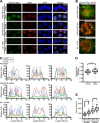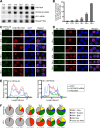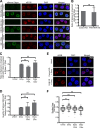Kaposi's Sarcoma-Associated Herpesvirus mRNA Accumulation in Nuclear Foci Is Influenced by Viral DNA Replication and Viral Noncoding Polyadenylated Nuclear RNA
- PMID: 29643239
- PMCID: PMC6002709
- DOI: 10.1128/JVI.00220-18
Kaposi's Sarcoma-Associated Herpesvirus mRNA Accumulation in Nuclear Foci Is Influenced by Viral DNA Replication and Viral Noncoding Polyadenylated Nuclear RNA
Abstract
Kaposi's sarcoma-associated herpesvirus (KSHV), like other herpesviruses, replicates within the nuclei of its human cell host and hijacks host machinery for expression of its genes. The activities that culminate in viral DNA synthesis and assembly of viral proteins into capsids physically concentrate in nuclear areas termed viral replication compartments. We sought to better understand the spatiotemporal regulation of viral RNAs during the KSHV lytic phase by examining and quantifying the subcellular localization of select viral transcripts. We found that viral mRNAs, as expected, localized to the cytoplasm throughout the lytic phase. However, dependent on active viral DNA replication, viral transcripts also accumulated in the nucleus, often in foci in and around replication compartments, independent of the host shutoff effect. Our data point to involvement of the viral long noncoding polyadenylated nuclear (PAN) RNA in the localization of an early, intronless viral mRNA encoding ORF59-58 to nuclear foci that are associated with replication compartments.IMPORTANCE Late in the lytic phase, mRNAs from Kaposi's sarcoma-associated herpesvirus accumulate in the host cell nucleus near viral replication compartments, centers of viral DNA synthesis and virion production. This work contributes spatiotemporal data on herpesviral mRNAs within the lytic host cell and suggests a mechanism for viral RNA accumulation. Our findings indicate that the mechanism is independent of the host shutoff effect and splicing but dependent on active viral DNA synthesis and in part on the viral noncoding RNA, PAN RNA. PAN RNA is essential for the viral life cycle, and its contribution to the nuclear accumulation of viral messages may facilitate propagation of the virus.
Keywords: DNA replication compartments; KSHV; mRNA localization; nuclear foci; viral noncoding PAN RNA.
Copyright © 2018 American Society for Microbiology.
Figures







Similar articles
-
The Expression and Nuclear Retention Element of Polyadenylated Nuclear RNA Is Not Required for Productive Lytic Replication of Kaposi's Sarcoma-Associated Herpesvirus.J Virol. 2021 Jun 10;95(13):e0009621. doi: 10.1128/JVI.00096-21. Epub 2021 Jun 10. J Virol. 2021. PMID: 33853955 Free PMC article.
-
A viral nuclear noncoding RNA binds re-localized poly(A) binding protein and is required for late KSHV gene expression.PLoS Pathog. 2011 Oct;7(10):e1002300. doi: 10.1371/journal.ppat.1002300. Epub 2011 Oct 13. PLoS Pathog. 2011. PMID: 22022268 Free PMC article.
-
Kaposi's Sarcoma-Associated Herpesvirus K8 Is an RNA Binding Protein That Regulates Viral DNA Replication in Coordination with a Noncoding RNA.J Virol. 2018 Mar 14;92(7):e02177-17. doi: 10.1128/JVI.02177-17. Print 2018 Apr 1. J Virol. 2018. PMID: 29321307 Free PMC article.
-
New insights into the expression and functions of the Kaposi's sarcoma-associated herpesvirus long noncoding PAN RNA.Virus Res. 2016 Jan 2;212:53-63. doi: 10.1016/j.virusres.2015.06.012. Epub 2015 Jun 21. Virus Res. 2016. PMID: 26103097 Free PMC article. Review.
-
PAN RNA: transcriptional exhaust from a viral engine.J Biomed Sci. 2020 Mar 7;27(1):41. doi: 10.1186/s12929-020-00637-y. J Biomed Sci. 2020. PMID: 32143650 Free PMC article. Review.
Cited by
-
Shaping the host cell environment with viral noncoding RNAs.Semin Cell Dev Biol. 2023 Sep 15;146:20-30. doi: 10.1016/j.semcdb.2022.12.008. Epub 2022 Dec 28. Semin Cell Dev Biol. 2023. PMID: 36581481 Free PMC article. Review.
-
Idiosyncrasies of Viral Noncoding RNAs Provide Insights into Host Cell Biology.Annu Rev Virol. 2019 Sep 29;6(1):297-317. doi: 10.1146/annurev-virology-092818-015811. Epub 2019 Apr 30. Annu Rev Virol. 2019. PMID: 31039329 Free PMC article. Review.
-
Two herpesviral noncoding PAN RNAs are functionally homologous but do not associate with common chromatin loci.PLoS Pathog. 2018 Nov 1;14(11):e1007389. doi: 10.1371/journal.ppat.1007389. eCollection 2018 Nov. PLoS Pathog. 2018. PMID: 30383841 Free PMC article.
-
Nuclear speckles - a driving force in gene expression.J Cell Sci. 2022 Jul 1;135(13):jcs259594. doi: 10.1242/jcs.259594. Epub 2022 Jul 5. J Cell Sci. 2022. PMID: 35788677 Free PMC article. Review.
-
Phase separation and DAXX redistribution contribute to LANA nuclear body and KSHV genome dynamics during latency and reactivation.PLoS Pathog. 2021 Jan 20;17(1):e1009231. doi: 10.1371/journal.ppat.1009231. eCollection 2021 Jan. PLoS Pathog. 2021. PMID: 33471863 Free PMC article.
References
-
- Arias C, Weisburd B, Stern-Ginossar N, Mercier A, Madrid AS, Bellare P, Holdorf M, Weissman JS, Ganem D. 2014. KSHV 2.0: a comprehensive annotation of the Kaposi's sarcoma-associated herpesvirus genome using next-generation sequencing reveals novel genomic and functional features. PLoS Pathog 10:e1003847. doi: 10.1371/journal.ppat.1003847. - DOI - PMC - PubMed
-
- Pfeffer S, Sewer A, Lagos-Quintana M, Sheridan R, Sander C, Grasser FA, van Dyk LF, Ho CK, Shuman S, Chien M, Russo JJ, Ju J, Randall G, Lindenbach BD, Rice CM, Simon V, Ho DD, Zavolan M, Tuschl T. 2005. Identification of microRNAs of the herpesvirus family. Nat Methods 2:269–276. doi: 10.1038/nmeth746. - DOI - PubMed
Publication types
MeSH terms
Substances
Grants and funding
LinkOut - more resources
Full Text Sources
Other Literature Sources

